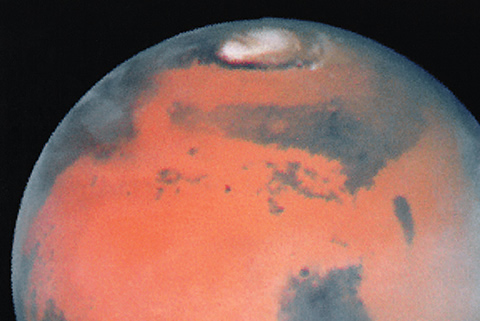Ever since astronomer Percival Lowell observed what he thought were canals on the surface of Mars more than a century ago, the possibility that the red planet harbours life – or did so in the remote past – has fascinated humankind. We now know that Lowell’s canals were an optical illusion, and that Mars is cold and dry. But scientists haven’t ruled out the possibility that microbial life might possibly lurk below the surface, and recent developments have prompted them to take a closer look.
The latest clue involves methane, a gas that may indicate the presence of living organisms. Astronomers have found that there’s significantly more of the gas on Mars than previously thought, and they want to know what’s producing it. Now a team of scientists – including several researchers from U of T – are developing an instrument designed to answer that question, among others.
The instrument is called the Mars Atmospheric Trace Molecule Occultation Spectrometer (MATMOS). While the Martian atmosphere is predominantly carbon dioxide, MATMOS will measure other gases that occur only in trace amounts. The instrument will fly aboard a robotic orbiter scheduled for launch in 2016.
Members of the team – including professors Barbara Sherwood Lollar of geology, Kimberly Strong and Kaley Walker of physics and Jonathan Abbatt of chemistry – will analyze the MATMOS data. Sherwood Lollar says there are two possibilities for the methane’s origin: biological, indicating that microbial life exists (or has existed) below the planet’s surface, or geological. If geological, the methane could stem from volcanic activity on Mars or from chemical reactions that take place when sub-surface water reacts with the surrounding rocks – something that Sherwood Lollar has studied extensively on our own planet.
The MATMOS detector will measure precisely how much methane is found in different regions on Mars, and how the concentrations vary from season to season. Scientists may then be able to pinpoint which regions are actually producing the methane, and perhaps target those areas for future rover missions.
MATMOS will also measure other trace gases, such as sulphur dioxide and hydrogen sulphide, and other molecules containing carbon, sulphur and nitrogen. The relative concentrations of methane and these gases will help researchers determine if the methane’s origin is biological or geological.
Leading scientists agree that the discovery of any trace of life on Mars – present or past – would be a tremendous breakthrough. But even if no signs of life are found, it would still be an important finding. Although Mars is a cold, dry planet today, scientists believe it may have been much warmer and wetter billions of years ago. If that’s the case, “scientists are eager to understand why life arose on Earth, but not on Mars,” Sherwood Lollar says.
Recent Posts
People Worry That AI Will Replace Workers. But It Could Make Some More Productive
These scholars say artificial intelligence could help reduce income inequality
A Sentinel for Global Health
AI is promising a better – and faster – way to monitor the world for emerging medical threats
The Age of Deception
AI is generating a disinformation arms race. The window to stop it may be closing





